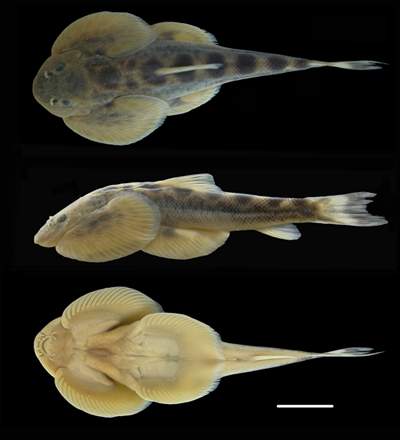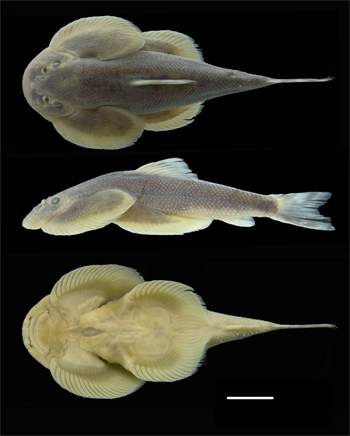|
CHINA SCIENCE AND TECHNOLOGY
NEWSLETTER
The Ministry of Science and Technology
People's Republic of China
|
|
|
N0.570 |
January 10, 2010 |
|
|
|
|
|
|
|
|
IN THIS ISSUE
|
|
*Digitized Environmental Protection
*New Sinogastromyzon Species
*New PTB Mechanism Unveiled
*Chinese Scientists’ Wonder Fabric
*H1N1 Test Kits into Market
*Mobile Emergency Generator
*Improved Wind Power Prediction
|
Digitized Environmental Protection
ZHOU Shengxian, Chinese Minister of Environment, recently pointed out that environment information is an important part of the national information buildup. In this context, information buildup meets the objective needs of global information process, and creates a ground for practicing scientific decision making in the area of environmental protection and associated monitoring. China will raise the service level in the area, and build a well functioned advanced digital environmental protection system. Efforts will be made to address redundant data collection and data sharing, heading for unified data sources and multiple utilizations and sharing of the data derived from the same source. By 2015, China will put into operation an environment information management system that meets the needs of environmental protection activities in the new era, with an environment information network covering the whole country and an enhanced environment information infrastructure, allowing the marriage of environment information and environmental protection activities. Efforts will also be made to digitize the core environmental protection activities, making environment information a resource, and information services regulated.
It was disclosed at the 1st national meeting on environment information that China has achieved positive progresses in building an environment information system that meets the needs of environmental protection management and decision making and associated public services. The central government has invested RMB 580 million to work on a digital environmental protection project (phase I), in an attempt to enhance the capacity building in the area, providing basic and application services for environmental protection activities at the national, provincial, municipal, and county levels.
|
INTERNATIONAL COOPERATION |
Enhanced Nitrogen Utilization
A cooperative project, jointly undertaken by Anhui Academy of Agricultural Sciences Rice Institute, Shanghai Academy of Agricultural Sciences Crop Institute, and Seoul National University, has bred out a new rice variety with an enhanced nitrogen utilization. The effort has found an effectively solution to addressing the nitrogen utilization problem commonly seen in rice breeding. The project has recently passed an approval check.
The collaboration between Chinese and Korean scientists has resulted in Xieyou 3026, Xieyou 9019 and K You52, new rice varieties with an enhanced nitrogen utilization. The novel rice varieties enjoy numerous merits, including enhanced nitrogen utilization, reduced cost of production, and alleviated environmental pollution.
Experimental results show that Xieyou 9019 has registered a nitrogen utilization 10% higher compared with Shanyou 63, with a per mu (1 mu= 0.0667 hectare) yield at 573.1kg, or 14.1% more than Shanyou 63, with a yield increase running between 11.85% and 16.26%. The efforts have led to the establishment of a string of hundred-mu and thousand-mu plots, pilot production lines, and production lines worth more than 2 million mu, with a direct economic return of RMB 200 million.
JIVET Technology Mastered
Researchers in Langfang, Hebei Province, have recently mastered juvenile in vitro embryo transfer (JIVET) technology to allow a one-year old calf to possess four to five calves of its own, narrowing down the generation gap by 1 year for a greatly raised reproduction rate. In 2005, Langfang based Xianghe Green Agriculture inked an exclusive accord with South Australian Research and Development Institute (SARDI) to import JIVET technology, in an attempt to breed more fine sheep, mutton, and cow species. Having mastered the JIVET technology, Chinese researchers have developed a proprietary JIVET technology platform, connected to SARDI, China Agriculture University, and the Chinese Academy of Agricultural Sciences, for diffusing the technology.
New Sinogastromyzon Species

Sinogastromyzon multiocellum.

Sinogastromyzon macrostoma.

Sinogastromyzon lixianjiangensis.

Sinogastromyzon tonkinensis.
Sinogastromyzon sits under CYPRINIFORMES, Balitoridae, and Balitorinae. Previous studies have recorded 19 valid species, mostly distributed across the upper Yangtze River, the upper Pearl River, Lixian River, Yuan River, and in the water systems of Taiwan, and the Red River and Song Ma River in the northern part of Vietnam. Not long ago, researchers at CAS Kunming Institute of Zoology have discovered four brand new species among the Sinogastromyzon specimens collected from Lixian River in Yunnan. The new species distinguish themselves from other known species in mouth, body color, sideline squama number, and fin number. Detailed comparisons confirmed the novelty. The new species have been named as Sinogastromyzon lixianjiangensis and Sinogastromyzon macrostoma. The other two are named as Sinogastromyzon multiocellum for a newly registered species, and Sinogastromyzon tonkinensis for the previously recorded one. The finding, published in the recent issue of Environmental Biology of Fishes, has made the Sinogastromyzon registered in China reach 13 in number, and deepened people’s understanding of the diversity and distribution of the species.
New PTB Mechanism Unveiled
A study team, led by ZHANG Yi and FU Xiangdong at Wuhan University College of Life Sciences, discovered that dominant PTB binding near a competing constitutive splice site generally induces exon inclusion, whereas prevalent binding close to an alternative site often causes exon skipping. The finding, published in the December 24, 2009 issue of Molecular Cell, overthrew the previous conclusion that PTB is a protein inhibiting protein.
ZHANG and coworkers unveiled the new features through the genome-wide analysis of PTB-RNA interactions, and published more than 4 million PTB-binding sites in cancerous cells on NCBI. It is believed that the new theory and associated techniques will lead to a new revolution in PTB-RNA interaction studies, allowing people for the first time in the world to see almost all the targets of cancer causing proteins within the cells. It is also a precious finding for understanding PTB’s cancer causing mechanism, and for developing corresponding new drugs as well.
Chinese Scientists’ Wonder Fabric
Prof. TANG Fangqiong with Technical Institute of Physics and Chemistry, part of the Chinese Academy of Sciences, and a research team led by Prof. LI Yi at Hong Kong Polytechnic University, have jointly developed a nanotechnology that can be used to work out a “wonder wool fabric” that shakes off wrinkles and shrinkage, and “breathes” to release sweat. Researchers coated the wool fabric with a very thin hydrophilic layer (1/50000 of a human hair) made up of silica nanoparticles. The particles make the wool superhydrophilic through changing the fabric’s surface energy and structure. Fortunately, the coating layer does not alter the wool’s color and texture, allowing daily dry cleaning. The finding, published in the recent issue of ACS News Service Weekly PressPac, has applied for a domestic invention patent, with its international application on the way.
H1N1 Test Kits into Market
A test kit able tell both type A and type B flu viruses, jointly developed by Southern Medical University Zhujiang Hospital and WODFO Biotech, part of South China University of Technology, has passed the registration approval of Chinese State Food and Drug Administration on December 30, 2009 for market access. Applied with advanced gold immunochromatography assay (GICA) and PCR techniques, the test kit is able to independently tell the results within 5-10 minutes, desirable for applications at diseases prevention and control centers, railway stations, entry-exit inspection and quarantine, schools, and neighborhood communities. Clinical trials organized by a number of authoritative institutions show that comparing with the imported products, it has an enhanced sensitivity and accuracy, enjoying fast test, simple operation, and low cost. In the context of throat swab specimen, the test kit has produced a sensitivity as high as 96.80%, and a clinical accuracy of type A and B differentiation of 99%.
Novel Wind Turbine Vane
Researchers, at Huachang Polymer, part of East China University of Science and Technology, have developed a production line able to annually produce 1,000 tons of special resins for manufacturing wind turbine vanes, based on their six-month efforts. The prototype products have been currently tested by one domestic and one overseas wind turbine maker. The development marks China’s possession of the key proprietary technologies to produce large wind turbine vanes using high performance epoxy vinyl ester resin, heading for developing the wind power products featured with high performance, multifunction, and harmless/environment friendly. The innovative technology has brought down the cost of raw materials, or 60% of the cost of an imported product. The new product shows fine bonding and dynamic performance, with a reduced shrinkage rate.
Proprietary IHNI
Not long ago, Chinese researchers put a proprietary in-hospital neutron irradiator (IHNI) into demonstration operation. According to experts, a boron compound would be injected into human body, which will flow into human brain through the blood circulation, before the irradiation. Neutrons would react against the tumor, and kill tumor cells within a preset range. Test results show that the demonstration device has reached its designed performance. The proprietary device has been granted with a national invention patent.
Mobile Emergency Generator
An emergency gas generator able to generate 1000KW-3000KW of electricity either in a fixed and mobile manner, developed by Harbin Dongan Engine, has recently passed an approval check. Researchers applied a range of new technologies and techniques to secure the quality performance of the emergency generator. Model QD15A is designed with a rated output worth 1500KW, and a work life for 15 years. Built on the vehicle based gas generator, the new model has seen a range of improvements, including power supply performance, structure integration, and environment adaptability. All the equipment needed for the operation, including the generator, gas tank, cable, and backup diesel generator, are housed in a container for the convenience of shipping. In addition, the generator is protected against salt erosion, dampness, heat, and moulds, for a prolonged work life.
Improved Wind Power Prediction
Researchers at the Solar Energy Resources Evaluation Center, part of China Meteorological Administration, have developed a meso-scale NWP model and statistics model based short range wind power prediction system, based on the historical wind power data. Researchers created a nonlinear model able to predict wind power every 15 minutes, based on the actual wind power data derived from 200 wind turbines at a wind farm in Gansu Province during the period of January 2008- April 2009, and on the meteorological elements fields collected in the same period.
To validate the results of the model, researchers made a prediction test during the period of January-December 2008. The comparison between the wind power prediction and actual wind power output at an interval of 15 minutes show that the model is able to predict the monthly wind power variations in a reasonable manner, with a limited error ranging between 2.76% and 12.89% under Root Mean Square, implying a fine application perspective as the model can predict the monthly peaks of wind power in a reasonable manner.
Comments or inquiries on editorial matters or Newsletter content should be directed to:
Department of International Cooperation, MOST 15B, Fuxing Road, Beijing 100862, PR China Tel: (8610)58881360 Fax: (8610) 58881364
http://www.most.gov.cn |

